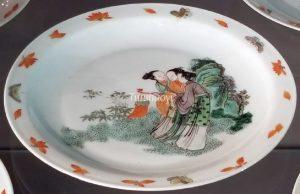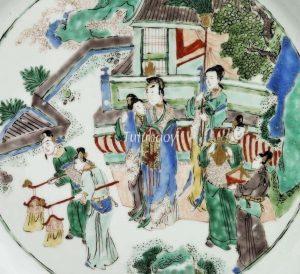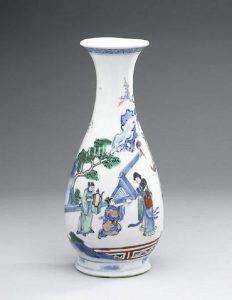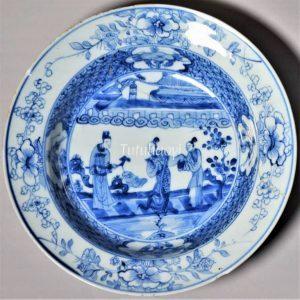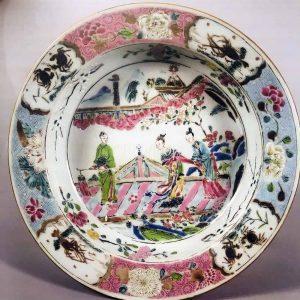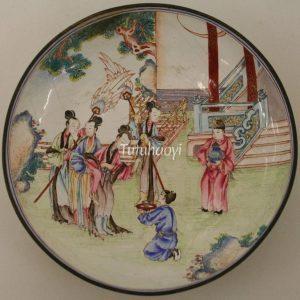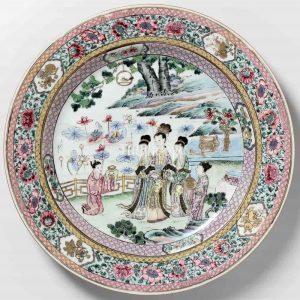Imperial Consort Lady Yang Getting Drunk
贵妃醉酒
© Tutuhaoyi.com owns the copyright of the description content for the images attached. Quoting all or part of the description content on this page is permitted ONLY IF ‘Tutuhaoyi.com’ is clearly acknowledged anywhere your quote is produced unless stated otherwise. (本页描述内容版权归Tutuhaoyi.com所有,转发或引用需注明 “Tutuhaoyi.com”, 侵权必究, 已注开源信息的条目除外。)
The play Polishing the Dust-covered Mirror (磨尘鉴 Mo Chen Jian) was compiled in 1619 by an obscure playwright Niu Ge (钮格), according to some twentieth-century researchers, including the eminent scholar of the field Zheng Zhenduo (郑振铎 1898–1958). The play portrays some colourful historical figures of the Tang dynasty (618–907) such as Emperor Xuanzong of Tang (name: 李隆基 Li Longji 685–762) and his famous consort Lady Yang Yuhuan (杨玉环 719–756), one of the Four Great Classic Beauties in Ancient China.
In Act 12, entitled ‘The Tipsy Consort (醉妃 Zui Fei)’, Lady Yang is drowning her disappointment in alcohol when the emperor fails to turn up at the Hundred Flowers Pavilion (百花亭), where they are supposed to meet that evening. Lady Yang spends her lonely night by abusing her attendant eunuchs and losing herself in intoxication. Eventually, Lady Yang staggers back to her own quarters swaying back and forth with her maids’ support.
Later, the plot was refined to become ‘Imperial Consort Yang Getting Drunk (贵妃醉酒 Guifei Zui Jiu)’, one of the best-known classic Peking opera episodes.
Check here for another story of Lady Yang: Imperial Consort’s Craving for Lychees 贵妃嗜荔
image identification and literature research by Dr Yibin Ni
Similar Figural Story Scenes for Differentiation:
Scholar Zhang Getting Drunk Due to Madame Cui’s Broken Promise 张生醉酒 (崔母悔婚)
Li Bai Getting Drunk 太白醉酒 (李白醉酒)
Fig 1-2: porcelain dish with overglaze enamelled decoration, Kangxi period (1662–1722), Qing dynasty, courtesy of The Trustees of the British Museum
Fig 3-4: porcelain dish with overglaze enamelled decoration, Kangxi period (1662–1722), Qing dynasty, courtesy of the Victoria and Albert Museum, London
Fig 5: porcelain vase with underglaze blue and overglaze enamelled decoration, Kangxi period (1662–83), Qing dynasty, courtesy of The Royal Ontario Museum, Canada, Object number: 909.8.21
Fig 6: porcelain dish with overglaze enamelled decoration, Kangxi period (1662–1722), Qing dynasty, courtesy of the Fitzwilliam Museum, the University of Cambridge
Fig 7: porcelain dish with underglaze blue decoration, 1725–1750, Qing dynasty, courtesy of the Victoria and Albert Museum, London
Fig 8: porcelain dish with overglaze enamelled decoration, Yongzheng period (1723–35), Qing dynasty, courtesy of Mr Wu Pei’s collection
Fig 9: copper dish with enamelled decoration, c.1730–1770, courtesy of the Victoria & Albert Museum, London
Fig 10: porcelain dish with overglaze enamelled decoration, c. 1750 – c. 1799, Qing dynasty, courtesy of the Rijksmuseum, Amsterdam
Fig 11: colour print, Qianlong period (1736–95), Qing dynasty, Taohuawu (桃花坞), courtesy of a private collection

